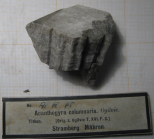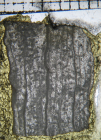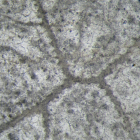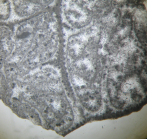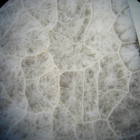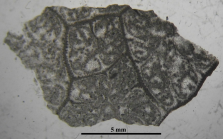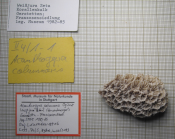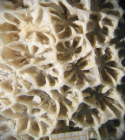
| Intro | | About | | Wiki | | Search traits | | Data explorer | | Literature | | Definitions | | Sources | | Webservices | | Statistics | | Feedback | | Editors | | Log in |
Scleractinia taxon detailsAcanthogyra Ogilvie, 1897 †
1439836 (urn:lsid:marinespecies.org:taxname:1439836)
accepted
Genus
Acanthogyra columnaris Ogilvie, 1897 † (type by subsequent designation)
marine,
fossil only
Ogilvie, M.M. (1897). Die Korallen der Stramberger Schichten. <em>Palaeontographica, A,.</em> 7, Suppl. 2: 73-284. [details]
Description Massive colonial corallum, cerioid. Intracalicular septal increase (or budding), irregularly polygonal corallites. Radial...
Description Massive colonial corallum, cerioid. Intracalicular septal increase (or budding), irregularly polygonal corallites. Radial elements compact flexuous septa s.s. Inner edges of septa, enlarged by teeth, are either free or fused to the columella. Lateral faces with granules. Bilateral symmetry of septal apparatus marked by a septum longer than others. Some lonsdaleoid septa. The wall is a thick compact septotheca of the same nature as the radial elements. Endotheca made of cellular rather than vesicular dissepiments. Initially styliform, the columella becomes lamellar. Synapticules absent. [details]
Hoeksema, B. W.; Cairns, S. (2025). World List of Scleractinia. Acanthogyra Ogilvie, 1897 †. Accessed at: https://www.marinespecies.org/Scleractinia/aphia.php?p=taxdetails&id=1439836 on 2025-05-27
Date action by
original description
Ogilvie, M.M. (1897). Die Korallen der Stramberger Schichten. <em>Palaeontographica, A,.</em> 7, Suppl. 2: 73-284. [details]
basis of record Cairns, S.D., R. Baron-Szabo, A.F. Budd, B. Lathuilière, E. Roniewicz, J. Stolarski & K.G. Johnson. (2010). Corallosphere. , available online at http://www.corallosphere.org [details] additional source Wells JW. (1936). The nomenclature and type species of some genera of recent and fossil corals. <em>American Journal of Science.</em> 31: 97-134., available online at https://ajsonline.org/article/61464 [details] additional source Kołodziej B. (2003). Scleractinian corals of suborders Pachythecaliina and Rhipidogyrina: discussion on similarities and description of species from Stramberk-type limestones, Polish Outer Carpathians. <em>Annales Societatis Geologorum Poloniae.</em> 73(3): 193-217. [details] additional source Eliášová H. (1973). Sous-famille Rhipidogyrinae Koby, 1905 (Hexacorallia) des calcaires de de Stramberk (Tithonien, Tchecoslovaquie). <em>Časopis pro Mineralogii a Geologii.</em> 18(3): 267-287, pls. 1-14. [details]  Present Present  Inaccurate Inaccurate  Introduced: alien Introduced: alien  Containing type locality Containing type locality
From editor or global species database
Description Massive colonial corallum, cerioid. Intracalicular septal increase (or budding), irregularly polygonal corallites. Radial elements compact flexuous septa s.s. Inner edges of septa, enlarged by teeth, are either free or fused to the columella. Lateral faces with granules. Bilateral symmetry of septal apparatus marked by a septum longer than others. Some lonsdaleoid septa. The wall is a thick compact septotheca of the same nature as the radial elements. Endotheca made of cellular rather than vesicular dissepiments. Initially styliform, the columella becomes lamellar. Synapticules absent. [details]Remark According to Beauvais (1970) Acanthogyra belongs to Pruvostastreidae, but Eliasova (1973) and Roniewicz (1976) assigned this genus to Rhipidogyridae on the basis of Acanthogyra columnaris in Eliasova 1973 which is a Columnogyra. Castiglionastrea Gill et al. is a junior synonym better preserved than the Ogilvie's type. 6 Jurassic and 2 Cretaceous nominal species. [details] Type designation Subsequent designation by Wells (1936) [details] From editor or global species database
|


